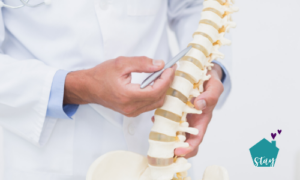 Because August is National Spinal Muscular Atrophy Awareness Month, family caregivers have an opportunity to find support and learn more about how to help aging relatives who have the disease. While spinal muscular atrophy, or SWA, can develop in childhood or adolescence, one type of this genetic condition presents in later adulthood. If an elderly adult is diagnosed with SWA, it’s important that family caregivers know what kind of care they need to stay safe and healthy in their own home.
Because August is National Spinal Muscular Atrophy Awareness Month, family caregivers have an opportunity to find support and learn more about how to help aging relatives who have the disease. While spinal muscular atrophy, or SWA, can develop in childhood or adolescence, one type of this genetic condition presents in later adulthood. If an elderly adult is diagnosed with SWA, it’s important that family caregivers know what kind of care they need to stay safe and healthy in their own home.
Here are 5 facts about spinal muscular atrophy in seniors that family caregivers and senior care providers should know:
1. Spinal Muscular Atrophy Affects the Muscles
This genetic condition causes muscle weakness that progresses over time. Eventually, it can cause the elderly adult to have little control over functions like reaching, grabbing, swallowing, walking and breathing. Most seniors with SMA eventually require help with numerous daily tasks.
2. There Are 4 Different Types of SMA
The different types of SMA are categorized by what age the disease presents itself. Type 1 happens right at birth or within a month or so of a child’s life. Type 2 describes SMA in infants who are six to 12 months old. Type 3 can happen anywhere from early childhood through adolescence. Type 4 manifests adults later in their life. Adult-onset spinal muscular atrophy is the type that affects elderly adults.
3. Symptoms of SWA in Seniors
With SWA, the muscles atrophy and weaken over time. The first symptoms in seniors include trouble walking, mild breathing issues, muscle tremors, twitching and problems with swallowing. Over time, seniors are unable to walk and face more serious problems with grabbing, grasping, reaching, swallowing and even breathing. Seniors with SWA eventually need a wheelchair or scooter and most cannot live independently without regular help from family caregivers and senior care providers.
4. Helping Seniors with SWA
When it comes to living with SWA, elderly adults must depend on family caregivers and senior care providers to help them out with basic tasks like dressing, bathing, grooming, meal preparation, housekeeping, pet care, hygiene and transportation. With a good support group of family, friends, neighbors and senior care providers and services, elderly adults can stay safe and happy in their own homes.
5. Raising Awareness for SWA
August is National Spinal Muscular Atrophy Awareness Month, which means that organizations across the country are putting a spotlight on the condition. Family caregivers and seniors themselves can get overwhelmed with the disease, and National Spinal Muscular Atrophy Awareness Month provides information on support groups, local and national resources and more.
While there’s no cure for spinal muscular awareness, it’s possible for elderly adults with the genetic condition to live productive and satisfying lives if family members do everything they can to ensure that their aging relative’s needs are taken care of.
For senior care in Cherry Hill, NJ, and the surrounding areas, call and talk to us at Home to Stay Healthcare Solutions (856) 321-1500.







